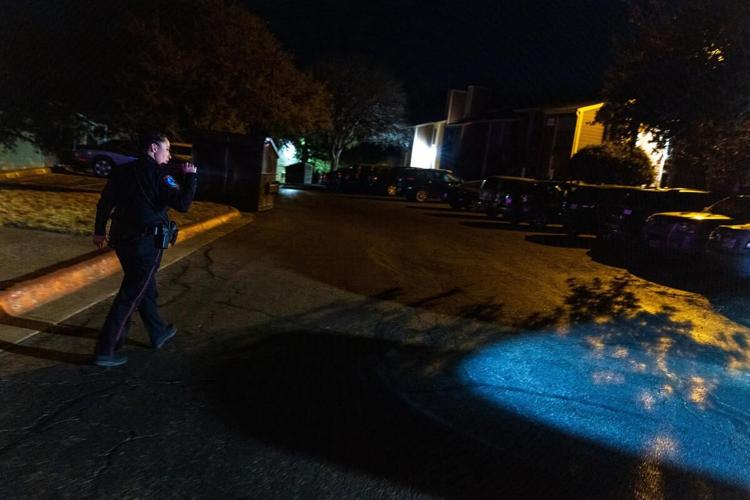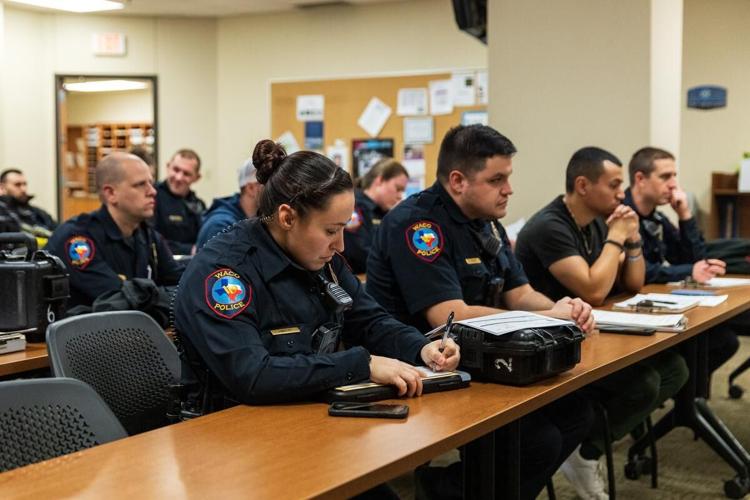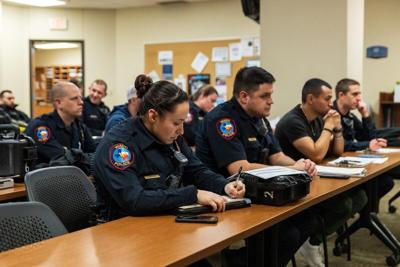WACO, Texas—Rookie officer Amanda Lindsey parks herself in the front row of the roll-call room inside Waco police headquarters, a towering former hospital that looms above the central Texas city. Dark hair twisted back into a bun, hefty utility belt (gun, Taser, handcuffs) fastened onto her five-foot-four frame, she scribbles down updates from a shift supervisor before heading out on a solo overnight.
A year before, Lindsey, in her late 20s, spotted a police recruiting billboard while waiting in the turning lane en route to the health care job she didn’t want. Training shifts were already proving the job switch right. She loved the variety, the chance to talk to people, to understand how their paths crossed and try to make a bad day better.
“I really like learning about people’s stories,” Lindsey says. “Especially, ‘How did you get here?’ Usually, you don’t wake up and say, ‘I’m going to be a troublemaker today.’”
Amid staffing crises in police departments across the continent — waves of officers are departing while applications are drying up — Lindsey, a community-minded and university-educated recruit, is highly sought after.
She also happens to be part of a North American hiring push that’s gained traction and urgency amid the reckoning, spurred by George Floyd’s 2020 murder, over deadly systemic racism in policing.

Rookie officer Amanda Lindsey out on patrol during an overnight shift.
Ilana Panich-Linsman for the Toronto StarAs women have broken into traditionally male sectors, policing has lagged behind. In the United States, women make up just 12 per cent of sworn officers. Canada sits at 23 per cent, well below England and Wales’ 35 per cent. The percentage of women in leadership roles is smaller still, at just three per cent stateside. While Canada’s promotion rates are higher — 18 per of senior officers today are women — some of the country’s biggest police departments have never had a female chief, including Toronto and Ottawa.
The statistics are on display in the Waco PD staff room, where Lindsey is outnumbered by male colleagues about five to one in the 260-person department.
Under the direction of a new chief who’s no stranger to smashing glass ceilings, the Texas city is trying to change that ratio, making it among a growing number of North American police departments that have committed not to feel-good intentions but hard numbers: at least 30 per cent women in recruiting classes by 2030. Major U.S. departments, including in New York and Los Angeles, have signed on alongside services in Saskatchewan, Alberta and British Columbia.
Creators of the so-called 30x30 Initiative say mass protests over racism and excessive force have awakened departments both to the benefits of employing women and to the public safety risks of the status quo. Based out of New York University’s non-profit The Policing Project, the initiative touts research suggesting women use less excessive force (and rely less on physical force to begin with), make fewer discretionary and race-based stops and are seen by the public to be more honest and compassionate.
“We used to give these talks and it would be to rooms full of women — very few men would show up. We were preaching to the choir,” said Ivonne Roman, co-founder of the 30x30 initiative and former Newark, N.J., police chief.
“After George Floyd, we really don’t recruit. Agencies come to us.”
But departments relying on women to usher in a new brand of policing face significant hurdles, outside the station and in. The effort to diversify ranks has for decades been presented as a fix to excessive force and systemic racism, to little effect, leaving many to see it as window dressing for departments ducking meaningful change.
Others worry the boys’ club is so entrenched women will be pushed out by the culture they’re trying to upend.
The chief of police
On the way into Chief Sheryl Victorian’s corner office is a wall of Waco’s former chiefs, 17 men staring out in two neat rows dating back nearly 150 years.

Chief Sheryl Victorian is Waco’s first Black woman police chief. She signed the department on to a pledge to hire 30 per cent women recruits by 2030. “The naysayers are going to be out there and I can’t let them interrupt the job and the work that I’ve set out to do, ” she said.
Ilana Panich-Linsman for the Toronto StarVictorian disrupted local history when she arrived in 2021 in Waco, a central Texas city of 140,000 likely best known to Canadians as the site of the deadly 1993 Waco Siege between federal law enforcement and religious cult the Branch Davidians (or, to HGTV aficionados, as the hometown of Chip and Joanna Gaines, of “Fixer Upper”). As a Black woman, she’s joined an especially exclusive, though growing, club in police leadership.
Like many female police leaders, Victorian boasts extensive experience, including undercover and beat work, alongside academic bona fides not expected of male predecessors — her PhD in criminal justice hangs around the corner from the wall of chiefs. Accolades and notes of congratulations blanket her office. She focuses on those when the discriminatory talk makes its way to her, as it did at an arbitration hearing for a cop she fired. She remembers lawyers had warned her there would be upsetting audio evidence of a cop from another agency complaining about her; it still roiled her stomach when it played. “First of all, she’s a woman,” Victorian said, recalling the officer’s words. “And then she’s Black.”
Discrimination exists in and out of the police station and “I try not to let that bother me much,” Victorian said in an interview at police headquarters earlier this year, the occasional thud of officer training echoing in a stairwell nearby.
“The naysayers are going to be out there and I can’t let them interrupt the job and the work that I’ve set out to do,” she said.
- Wendy Gillis
That work involves building back public trust. After George Floyd’s murder, she found herself crying, thinking of her brother who was the same age as Floyd and realizing what the fury in the streets meant for her profession. “Oh my God, people hate us so much they’re burning down the police station,” she said.
In the weeks after, while an assistant chief with the Houston police, Victorian created a mandatory training course on the historical traumas of policing. The course, which she said Waco would adapt, covers the profession’s role in enforcing segregationist laws in the Jim Crow South and local examples of anti-Black racism that strained police-community relations. The aim is to show the roots of public mistrust; that “no one woke up one day and said, ‘I want to hate the police,’” she said. “There’s some history there.”
Under Victorian’s leadership, Waco became one of the first U.S. police agencies to sign the 30x30 pledge. She’s matter of fact about why: Police services need to take whatever steps they can to prevent the use of force and, citing research and experience, she believes women use less.
That was evident from her days on the beat when she realized she could talk down a volatile situation sometimes exacerbated by a male colleague’s aggressive approach. Several of the female officers interviewed for this story said they felt they were skilled at verbal de-escalation even in circumstances where a colleague might resort to force.
Research tends to back up the anecdotes. A 2017 study examining 54 U.S. departments found women were nearly three times less likely to fire their guns than men, a gender difference that remains “significant” even after controlling for factors including job assignment. In 2021, the journal Science published the results of an ambitious study examining millions of Chicago police interactions, finding women used 28 per cent less force than men while making seven per cent fewer arrests.
Cara Rabe-Hemp, an Illinois State University professor of criminal justice who has studied gender differences in policing for about two decades, has “consistently” found women use less force, especially extreme or controlling levels. That’s true even when force might be considered justified.
“We actually found that when we’re looking at force used against women police, that they have the same rates of violence” as male counterparts, she said.
Determining the cause of gender differences is complex and risks making stereotypical or sexist conclusions, including that women are more nurturing or communicative than men. But societal gender norms nonetheless may play some role, Rabe-Hemp said. A citizen’s assumptions about female cops may affect their own behaviour, changing the outcome of a stop regardless of the officer’s actions, she said.
Other research has found few differences between men and women when it comes to the use of force, and is mixed on the broader effect of racial and gender diversity in policing. High-profile cases, meanwhile, raise questions about whether diversity can reduce violence: Black motorist Daunte Wright was shot dead by Minnesota cop Kimberly Potter in 2021 after she mistook her gun for her Taser. In January, Black man Tyre Nichols was beaten to death, allegedly by five Black police officers in a Memphis department led by a Black woman who’d created the so-called Scorpion unit that was blamed especially for its aggressive tactics. Closer to home, a rookie Peel Regional Police officer resigned and was convicted of careless use of a firearm in 2021 after she shot a Black woman in Mississauga.
Research by Samantha Simon, an assistant professor at the University of Missouri’s department of criminology and critic of the Policing Project’s 30x30 initiative, concludes the problem is not the lack of diversity but the overarching culture, namely, an entrenched “warrior” mentality.
Simon spent a year conducting field research at four U.S. police academies and found an overwhelming emphasis on the dangers of policing. Cadets were shown graphic videos of officers being beaten or killed, and training supposedly intended to identify dangerous behaviour instead taught officers to view racialized men, specifically, as the enemy. Officers were taught to “think about violence as a moral necessity,” Simon found.
“I am certainly not advocating for a police force composed exclusively of white men,” Simon wrote, “but I am arguing that reform efforts should not consider demographic diversity, in and of itself, to be a cure-all for racism and violence in policing.”
Why 30 per cent represents a ‘critical mass’
“How honest can we be?” Sgt. Melissa Thompson asks with a half smile, casting her eyes out of her SUV to Waco’s wide residential streets. She pauses before sharing how some colleagues responded to the news Waco was getting a female chief.

Sgt. Melissa Thompson applied for a promotion after a Black woman came to lead her police department. “I need to get into a position to try to help make this change too,” she said.
Ilana Panich-Linsman for the Toronto StarBeing a cop hadn’t been Thompson’s plan. Growing up in Los Angeles after the infamous police beating of Rodney King in 1991, she and her older brothers “didn’t always have the greatest view of policing,” said Thompson, who is Black. But after moving to Waco and getting pregnant at 18, she realized minimum wage wasn’t going to raise her family. She enrolled in the police academy after doing a ride-along for a college class.
More than 15 years in, she loves the job and sees the benefits of being a Black woman doing it. In racially diverse neighbourhoods, she notices residents relax when they spot a cop who looks like them. And she’s brought her brothers around to her chosen profession.
“I think they look at it from the viewpoint of, ‘OK, at least we know you’re out trying to change some of those narratives’” about what it is to be a police officer,’” she said.
That change hasn’t come in a straight line. Things have improved since an instructor at the police academy told her she couldn’t wear her hair in cornrows. But the response to Victorian’s promotion as chief amongst some colleagues made Thompson see there’s still work to do.
“When she was coming in, I heard some of the guys talking, you know, ‘A female’s coming in. How is she going to be? Is she going to be this, is she going to be that.’ I kind of got defensive,” Thompson said.
A boys’ club culture has for decades been cited as a reason the profession remains a mostly white, male and heterosexual workforce. Across North America, lawsuits, human rights complaints, independent reports and whistleblower accounts expose toxic workplaces for female, racialized and LGBTQ officers, with problems ranging from male-centred policies and equipment to racist and homophobic jokes to sexual harassment.
Even at events held to recruit female officers, Roman, the former Newark police chief, has seen the thinking that keeps them sidelined. During one event, a male police employee said he wanted to hire more women but didn’t know how to handle the sexual harassment complaints it would generate.
“We were stunned. I said, ‘Sir, you’re talking about an issue with the culture. It’s not the women that’s the problem,’” she said.
Before she joined Waco PD, Det. Migdalia Gamiz left a job she’d once loved with a sheriff’s department due to sexual harassment she had witnessed. She and others spoke out, but little came of it, she said. “I was thinking about just being done with law enforcement in general,” she said.
But Gamiz loved policing and later jumped at the chance to wear Waco’s badge. She worries about sexual harassment in her profession but feels she can be part of the solution. Colleagues know her as someone others can turn to if they encounter harassment on the job, she said.
A “strength in numbers” approach is indeed what’s behind the 30 per cent goal. The target was chosen based on research indicating that at that threshold, a minority group reaches a critical mass. Above it, they can impact overall culture. Below, the under-represented group often must assimilate into the culture to survive.

Det. Migdalia Gamiz inside police headquarters. After resigning from a job with a sheriff’s department due to sexual harassment she had witnessed, Gamiz jumped at the chance to wear Waco’s badge.
Ilana Panich-Linsman for the Toronto StarThat pressure to be “one of the boys” has been found in Canadian research conducted by Lesley Bikos, an assistant professor of sociology at Western University. A former London, Ont., cop, she once advocated for greater female representation as a means to transform police culture, but is today pessimistic about it being a change agent.
Hiring more predominantly white women has had little impact on police culture in Canada, Bikos said; despite having stronger female representation for longer than the U.S., problems with racism and sexism persist. Her research has found that either women themselves perpetuate the status quo culture, or those who speak out against wrongdoing suffer consequences, including retribution, discrimination or a career stall.
She notes that in London, England, where female officers have surpassed the 30 per cent threshold, a landmark review released in March concluded that city’s Metropolitan Police was institutionally racist, homophobic and sexist.
“While I understand the critical mass argument and agree representation matters, a more nuanced discussion is needed,” Bikos said.
Encouraging departments to reach that 30 per cent threshold is only the first step, say those behind the 30x30 initiative. Police agencies who sign on need also take action to ensure female officers not only stay but move up, in turn affecting the broader culture.
Some changes are practical. Acting on research that some female officers don’t stay or seek promotions because of family responsibilities, departments should have designated pumping rooms for nursing cops, consider offering on-site daycare and create more flexible work schedules. Other recommendations are explicitly aimed at tackling discrimination and harassment, from tracking completion rates for sexual harassment training to holding focus groups with officers on the department’s culture and advancement opportunities. Agencies are also encouraged to collect and analyze data on gender and race in hiring and promotions to detect biases in the process.
“We don’t want to set women up to walk into a culture where it’s going to be toxic for them,” said Roman. “So it’s not just addressing the recruitment, but their experiences while they’re there and then on their promotion ability.”
Having women in positions of power can have a knock-on effect. That much was true for Thompson, who — after spending many years on the force with no aspirations of moving up — recently put in for promotion. It was Victorian’s arrival as chief, combined with those comments from a few male colleagues about it, that inspired her.
“I know I need to get into a position to try to help make this change, too,” she said.
She’s now the second Black woman to reach the rank of sergeant at Waco PD. She went back to school to earn a Master’s degree and aims to keep rising through the ranks.
Life as a ‘new school’ cop
Fifty-five minutes into Officer Lindsey’s solo shift, a call went out about a missing boy. The five-year-old had vanished while left momentarily alone in the car, parked out front of a tight row of townhouses. As the clock ticked towards midnight, a sharp Texas-in-January chill had settled in; the child was wearing only a light jacket.
By the time Lindsey arrived, the parking lot was full of cruisers, a sheriff’s department helicopter was beaming its glaring spotlight over a nearby grassy park, and a heat-detecting drone hovered nearby. The boy’s nerve-wracked family huddled on their front steps. An Amber Alert was the next step.
Lindsey got out of the car, flicked on her flashlight and began searching a nearby dumpster, wondering if the boy hadn’t actually gotten far. Meanwhile, Officer Kelsey Lawrence — another recruit recently hired by Waco — began checking the doors of the dozens of cars inside the parking lot.

Amanda Lindsey and fellow new recruit Kelsey Lawrence smile after a missing five-year-old boy is found.
Ilana Panich-Linsman for the Toronto StarSure enough, a moment after Lawrence tried the locked handle of a red sedan, the boy emerged from the car, dazed. It appeared he’d wandered off, climbed into a stranger’s car and taken a nap. As the boy’s family cried with relief, Waco’s female rookies watched and grinned, happy to have played a part in the outcome.
Lindsey climbed back into her cruiser, quipping that it’s just another day in her new life as a cop. “Sometimes it’s traffic stops, sometimes it’s missing kids.”
Like her chief, Lindsey believes initiatives like 30x30 could improve the profession she’s now chosen. But she also believes policing is in the midst of a broader generational shift.
Anyone who’s become a cop in the last few years has done so at a time of upheaval and scrutiny, she said. These officers know what they’ve signed on to; they are on camera and under the microscope, so if they’re not in it for the right reasons, it’s quickly clear, she said. Regardless of gender, there’s a “new school” of officers who want to be a part of changing the face of the profession, Lindsey said.
“I think it’s more of an unspoken commitment that all of us new people … collectively want to be better,” she said.
Beyond the Badge
“Beyond the Badge” is an occasional series examining efforts outside our borders to redesign public safety and combat violence at a time of a continentwide crisis of trust in policing — with an eye to understanding challenges and finding solutions.
The series is made possible with the financial assistance of the R. James Travers Foreign Corresponding Fellowship. This international reporting bursary reflects the importance that Jim Travers attached to his six years reporting from Africa and the Middle East. He believed Canadians deserve first-hand, in-depth coverage of important international stories. He argued passionately that it is crucial for Canadian reporters to bear witness — because in our interconnected world, “foreign” news is local news.
Other stories in the series:




























To join the conversation set a first and last name in your user profile.
Sign in or register for free to join the Conversation